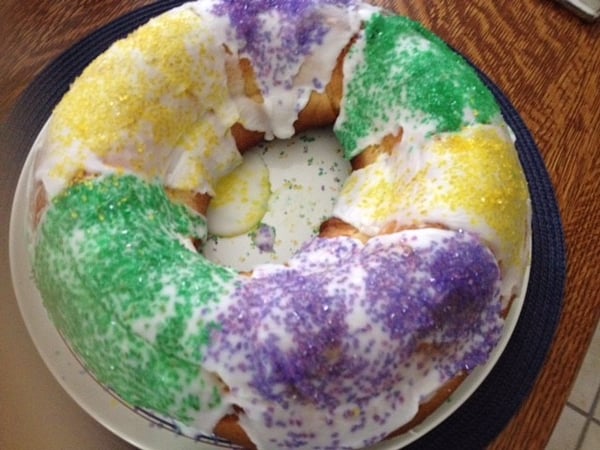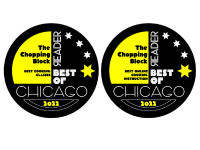My birthday always falls around Mardi Gras. Growing up in Southern Louisiana, that was a blessing. That meant an annual trek to New Orleans for parade watching, bead catching and all-around debauchery. This year, I returned to Louisiana with a Chicago friend to give her a culinary tour of my favorite part of the country. We dined on Muffaletta's from the famous Napoleon House in New Orleans, Fried Shrimp & Oyster Po-Boys at my old hang-out The Chimes in Baton Rouge and Boiled Crawfish complete with live Cajun music at Randol's in Lafayette. We even toured the Tabasco plant on Avery Island and learned they ferment the peppers for three years before processing the spicy, vinegary goodness. The one thing we didn't do? Eat King Cake!

King Cake comes in a variety of styles and flavors. The most traditional is a ring of twisted bread similar to that used in brioche topped with icing and sugar in the Mardi Gras colors of purple, green and gold. Of course, the Cajuns have improved on this model and choose to deep fry the cake just like a doughnut and fill it with cream cheese or praline flavored cream. Yum!
The best part of a King Cake is that there's a trinket hidden inside, traditionally a small plastic baby. Unfortunately, this is now considered a choking hazard, so you see less and less of the babies these days. Whoever finds the trinket is considered King or Queen of the day and must provide the next king cake or host the next Mardi Gras party.
We saw many different types of mixes for King Cake in Louisiana (even some designed for bread machines), but it's actually just like making bread from scratch. Try it for your Fat Tuesday celebration today!
Here's a recipe for King Cake from the kitchen of Frank Speyerer who is originally from New Orleans. Frank is now retired and living in Arlington, Texas but enjoys New Orleans style cooking and collecting and developing recipes.
King Cake
Serves 8
Ingredients: Cake
- ½ cup warm water (100° to 110° F)
- 2 teaspoons white sugar
- 2 (.25 ounce) envelopes Fleischmann's RapidRise™ yeast
- ½ cup warm milk (105° to 115° F)
- ½ cup sugar
- ½ cup melted butter – cooled
- 2 teaspoons salt
- 4-5 cups bread flour
- 4-5 teaspoons vital wheat gluten (optional)
- 5 egg yolks
- 1 teaspoon anise extract
- 1½ teaspoons ground nutmeg
- - grated lemon zest from lemon
- - vegetable oil/shortening
- 1 plastic baby toy
Ingredients Glaze: (Yield: 1½ cups)
- 2 cups sifted powdered sugar
- 1 teaspoon almond extract
- 2-3 Tablespoons water
Ingredients Decoration:
- - Purple, green and gold sugar sprinkles
Method:
- Dissolve 2 teaspoons sugar in ½ cup warm water in a small bowl.
- Add 2 envelopes Fleischmann's RapidRise™ yeast.
- Mix well and let stand in a warm place for about 10 minutes until yeast resembles creamy foam.
- Meanwhile scald milk by heating it in a heatproof glass container in a microwave oven until milk is just hot with steam and small bubbles appear around the edges; do not boil.
- Combine the milk, sugar, butter and salt in the mixing bowl and cool to lukewarm.
- Stir in 2 cups of the flour and beat well.
- Add the yeast mixture and the slightly beaten egg yolks one egg at a time.
- Stir in the grated lemon peel, anise extract and
- Gradually add the remaining flour one cup at a time.
- Using a dough hook beat for 10 minutes on low speed.
- Once all the dry ingredients are in come up to speed #2 for 5 minutes or until the dough begins to pull away from the sides of the bowl.
Note: If you do not have a mixer with a dough hook, simply knead the dough on a floured surface until it is smooth and elastic, about 15 minutes.
- Turn out on a lightly floured surface and knead for 8 to 10 minutes, until the dough is smooth and elastic, adding flour as necessary to prevent stickiness.
- Place in a well-greased bowl and turn it to oil all sides.
- Cover the bowl with plastic wrap, set in a warm (85°), draft-free place, and let rise until doubled in size, about 1½ hour.
Note: A closed unlit gas oven is an excellent draft-free place. The heat from the pilot provides adequate warmth for proper rising. With an electric oven, turn to 150° for about 3 minutes, then turn off the heat and open the door for 3 minutes. Place the bowl of dough in the oven and quickly close the door. This will give you an approximate temperature of 85°, just right for even and fairly quick rising.
- Punch dough down and turn out onto a lightly floured surface.
- Poke hole in dough and shape dough into a circle.
- Pull the dough into the shape to fit your ceramic French Savarin pan or circular baking pan.
- Spray the pan with non-stick flour spray and place the dough in the pan.
- Press the plastic baby toy into the ring from the bottom so that it is completely hidden by the dough.
Note: If you do not have a ceramic French Savarin pan:
- Shape dough into a cylinder 30 inches long and 6 inches in diameter. Place dough roll on a lightly greased baking sheet.
- Bring ends together to form an oval ring, moistening and pinching edges together to seal.
- Place a well-greased 2-pound coffee can in the center of the ring to maintain the shape during baking.
- After baking remove the coffee can immediately.
- Cover the ring with a towel and place in a warm, draft free place. Let the dough rise for about 45 minutes or until the dough doubles in size.
- Preheat the oven 350° F.
- Bake at 350° for 30 minutes or until internal temperature is 190°.
Note: To prevent the cake from getting too brown on top tent the top with foil when it is just golden brown.
- Remove the cake from the circular pan.
- Allow the cake to cool on rack.
- Make the icing.
- Combine the 1 teaspoon almond extract, the water and 2 cups sifted powdered sugar in a medium mixing bowl.
- Stir to blend well.
- With a rubber spatula, spread the icing evenly over the top of the cake (or drizzle, as desired.)
- Immediately sprinkle the colored sugars in 2- to- 3 inch alternating rows of purple, green and gold.
- Cut and serve.
Note: The cake is traditionally cut into thick slices and served to all guests.
Frank also shared his story of how the King Cake came to be.
Frank's Story of the King Cake
The story of the king cake begins, like the story of Mardi Gras itself, with the pagans. They had a celebration where a young man from the village was chosen to be treated like a king for a whole year. He was not denied during his reign, but after the year was over he became a human sacrifice to the gods. To eliminate this pagan custom, the Christian Church encouraged an observance calling for the preparation of a king cake containing a bean; whoever received the slice with the bean became king for a week and was allowed to choose a queen to reign with him. This took the place of the sacrificial pagan rite.
The King Cake tradition is believed to have been brought to New Orleans, Louisiana, from France in the 1870's. It evolved from the Twelfth Night or Epiphany pastry made by those early settlers. They added their own touches with the Spanish custom of choosing Twelfth Night royalty.
In European countries, the coming of the wise men bearing gifts to the Christ Child is celebrated twelve days after Christmas. The celebration, called Epiphany, Little Christmas on the Twelfth Night, is a time of exchanging gifts and feasting. All over the world people gather for festive Twelfth Night celebrations. One of the most popular customs is still the baking of a special cake in honor of the three kings..."A King's Cake" or Gateau de Roi.
A King Cake's ring shape, too, is significant, as some believe it symbolizes the unity of all Christians, and others believe it aptly resembles a king's crown.
A dried bean was originally hidden inside the cake but was replaced by coins, peas, pecans, rubber dolls, porcelain dolls, and in recent years plastic dolls. Starting around the 1930s, a tiny naked baby (Frozen Charlotte) was used instead of the bean or pea. The baby can be pink, brown, or golden. Some people believe that the baby represents the baby Jesus because Twelfth Night was when the three kings found the baby in Bethlehem.
Tradition has it that the person who finds the baby in the king cake is the next queen or king, he or she receives a year of good luck, is treated as royalty for that day and must host the next king cake party.
King Cake season lasts throughout Mardi Gras from the feast of the Epiphany until Mardi Gras Day.
The royal colors of purple, green and gold on the cake honors the three kings who visited the Christ child on the Epiphany. Purple represents Justice. Green stands for Faith. Gold signifies Power.
The three colors appeared in 1872 on a Krewe of Rex carnival flag especially designed for the visiting Grand Duke of Russia. He came to New Orleans just for the carnival, and the universal colors remain his legacy.
If you want to taste authentic King Cake, join The Chopping Block for our Mardi Gras Madness celebration at the Merchandise Mart on Friday, February 24 at 6:30pm. Laissez les bons temps rouler!









